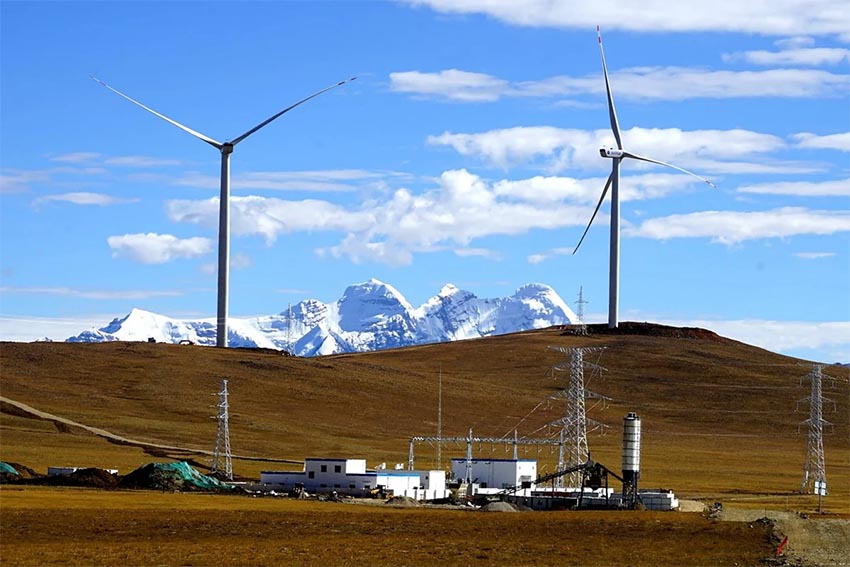|

October
6, 2023
By
Chuqin Jiang
China wind farm sets high-altitude
records, but how do turbines keep up in the thin Himalayan air?

China has expanded its
highest-altitude wind farm, in the Tibet autonomous region, thousands
of metres above sea level. Photo: China Three Gorges Corporation
China’s push for clean energy is testing the
limits of high-altitude wind turbines in the same mountain range as
Mount Everest, up where the air is rather thin.
In the Tibet autonomous region, phase two of the Zhegu Wind Farm, in
the northern foothills of the Himalayas, was put into operation in
Comai county on Wednesday, when 15 newly installed wind turbines were
connected to local power grids.
The project, funded by the state-owned Three Gorges Corporation, is
hailed as China’s highest-altitude wind farm, with parts up to 5,200
metres (17,000 feet) above sea level.
The 15 new turbines, with single-unit capacities of up to 3.6
megawatts (MW) – a record for high-altitude wind farms in China – are
expected to generate 200 million kilowatt-hours of clean electricity a
year. That’s equivalent to the annual power consumption of 140,000
local households, or more than 10 per cent of all Tibet families,
according to a statement by Three Gorges on WeChat.
"We are dispelling the misconception that
it is inefficient to develop wind farms on a plateau
Wang Liang, local project overseer"
Its annual power generation, if fully realised,
could save more than 60,000 tonnes of coal every year, reducing
173,000 tonnes of carbon dioxide emissions and 20 tonnes of sulphur
dioxide emissions, according to state news agency Xinhua.
“[The wind farm] is expected to drive local economic and social
development, improve local energy structure, and promote tourism to
Zhegu Lake, which will have a positive effect on the country’s rural
revitalisation,” China’s State-owned Assets Supervision and
Administration Commission said in 2021 upon completion of the
project’s first phase.
China, the world’s largest renewable-energy producer, was generating
36.2 per cent of its electricity from non-fossil fuel as of 2022,
according to an electric-power report by the China Electricity Council
in July. In total, 8.8 per cent of China’s electricity comes from
wind.
The nation’s installed windpower capacity reached 365 gigawatts (GW)
last year, accounting for 40 per cent of the global total and leading
the world for 13 straight years.
“We are dispelling the misconception that it is inefficient to develop
wind farms on a plateau,” Wang Liang, one of the local project
overseers, was quoted as saying by state broadcaster CCTV.
As the amount of turbine-generated wind energy is
correlated with both air density and wind speed, a turbine’s
efficiency is lowered by the thin air in high-altitude areas.
This increases the circumference of the rotating
blades by nearly 30 per cent.
To function efficiently in the extreme environment, all turbines are
equipped with elastic coatings, UV and lightning-protection modules,
and thick cables, according to comments in state media by the
project’s technical director, Li Chunshan.
The wind-farm expansion in Zhegu adds at least 48MW to China’s total
installed capacity, contributing to its full-year target of 430GW
while getting the nation a little closer to Beijing’s stated goal of
being carbon neutral by 2060.
Tibet has been a pilot region in central
leadership’s push for green-energy development. The clean energy
generated there will be both used by local residents and sent to other
provinces. It is expected to transmit 1.82 billion kilowatt hours to
12 destinations this year, while generating a profit of about 500
million yuan (US$68.5 million).
The Qinghai-Tibet Plateau is one of China’s three major windpower
areas, and the potential capacity for wind resources there accounts
for about 26 per cent of the country’s total, according to a
peer-reviewed report by China’s National Climate Centre last year.
Three Gorges Corp, which also operates the country’s largest
hydropower dam, finished another wind farm in Fujian province last
month, with installed capacity of 111MW. Its offshore turbines are
said to have the world’s largest single-unit capacity: 16MW.
Green Play Ammonia™, Yielder® NFuel Energy.
Spokane, Washington. 99212
509 995 1879
Cell, Pacific Time Zone.
General office:
509-254
6854
4501 East Trent
Ave.
Spokane, WA 99212
|